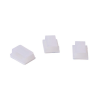I am very grateful for the instructions on how to repair the actuator. I found that I had to do something slightly differently and I have attached a photos of what I found worked for me. I have two Samsung printers. On one they insisted on selling me a completely new actuator assembly (that I had to wait weeks for the assembly to arrive). With these instructions my C-3060 FW was back in operation in a half hour).
I found that on my C3060 FW that the pad wouldn’t move so I (after much trial and error) I removed the pad completely. I had some extra foot pads from some electronic equipment that were sticky on one side. I had to cut them to size to fit under the actuator arm. I also found out that the thickness was important. If they weren’t the correct thickness either the printer would endlessly cycle, or the print was washed out with sections missing. The tape method didn’t work for me. By trial and error, I thinned out the pads to the right thickness, stuck it on to the actuator and it worked well. I used forceps, scissors and a Phillips screwdriver to complete the repair.
Here are samples of the common self-stick footpads I used, significantly enlarged. Note their actual size is 11 x 3 mm not including the removable backing covering the sticky side.
I cut these down with scissors until they eventually were only slightly thicker than the original pad but still slightly larger so even if they shift they would still work as a stop (The thickness should end up 1 to 1.5 mm). I suggest one degrease their hands and fingers with alcohol before doing this so as not to ruin the glued side. The best way to do this is to remove the single screw holding the actuator arm in place so one can easily access the space under the arm.
Here is the view of the actuator arm showing the single screw that should be removed to easily access the pads.
Here is a view of the new pad to the left and the original pad to the right of the actuator arm
Red arrow new pad. Green arrow the original pad that did not need to be replaced. Note that I tried to closely match the thickness of the remaining pad.
I hope that this helps someone else to avoid unnecessary expense and lost time.
William Lipsky
 pads that were there. The second time used rubber cement with the pads removed and the nylon roughed up. The mounts got brittle.
pads that were there. The second time used rubber cement with the pads removed and the nylon roughed up. The mounts got brittle.
